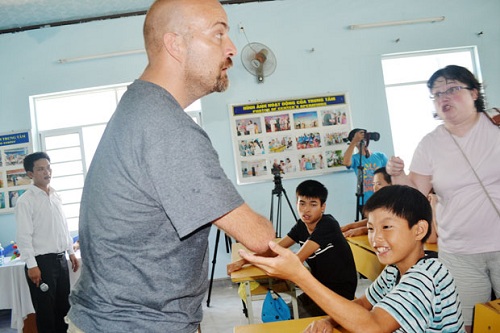Second and third generations of US AO victims visit Da Nang
A group of second and third generations of Agent Orange (AO) victims from the USA have recently visited children at Shelter No 3 of Da Nang’s Care Centre for AO Victims and Disadvantaged Children. During their stay there, the US guests had the opportunity to meet and participate in cultural exchange activities with the victims.
Amongst the visiting guests is Mrs Heather Bowser, a second generation victim, who has no right leg and deformed fingers. Mrs Bowser said that she has now visited Da Nang four times, and she always feels at home when she visits the shelter. She said that there was no equivalent centre in the USA. She expressed, therefore, her hope that one be established in her country and to allow her, and others in a similar situation, to become involved in entertainments, studying and sharing difficulties in their lives.
 |
| An AO-affected child touching Josh Kelly’s stump |
Mrs Bowser said that her fellow-traveller on this trip to Da Nang was her 13-year-old son, a third generation victim. She said she hoped that he would now no longer feel a complex about his defective body, and that he would confidently integrate into the community after this trip.
Another special guest is Mrs Bowser’s close friend, Josh Kelly, who is also a second generation victim. He was born with incomplete arms and only one leg. During his visit to the shelter he presented many drawings, drawn by his neighbours, to local AO-affected children. With the drawings featuring many stars, hearts, flowers and smiling faces, Mr Kelly wanted to encourage children exposed to AO to take pride in themselves, and never give up on their dreams.
The Iranian filmmaker Vahid Faraji Ghahreman said that he had visited many countries where AO victims lived, and he had learnt about toxic chemicals. He said that he was very happy to meet with the city’s AO-affected children. He was really impressed by the care and support given to local AO children by the city’s authorities and its people, he added. He remarked that he wanted to make a reportage video about war victims which would become undeniable evidence for proving a war crime. This would also help people around the world to understand more about the post-war consequences in order to assist in the struggle for peace.